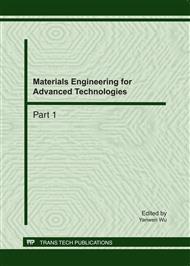[1]
SHANNON CE. A mathematical theory of communication [J]. Bell system Technical Journal. 1948, 27: 379-423, 623-656.
DOI: 10.1002/j.1538-7305.1948.tb00917.x
Google Scholar
[2]
CAIRE G, SHAMAI S. On achievable rates in a multi-antenna broadcast downlink [J]. IEEE Transactions on Information Theory, 2003, 49: 1691-1706.
DOI: 10.1109/tit.2003.813523
Google Scholar
[3]
SHIN Hyundong, LEE JH. Capacity of multiple-antenna fading channels: spatial fading correlation, double scattering and keyhole [J]. IEEE Transactions on Information Theory, 2003, 49(10): 2636-2647.
DOI: 10.1109/tit.2003.817439
Google Scholar
[4]
FOSCHINI GL. Layered space-time architecture for wireless communication in a fading environment when using multi-element antennas [J]. Bell Laboratories Technical Journal, 1996, 1(2): 41-59.
DOI: 10.1002/bltj.2015
Google Scholar
[5]
FOSCHINI GL, GANS M. On limits of wireless communications in a fading environment when using multiple antennas. Wireless Personal Communications. 1998, 6(3): 311-335.
DOI: 10.1023/a:1008889222784
Google Scholar
[6]
Francois H, Eduardo LE, Liesbet VP. STBC for uplink single-carrier CDMA with equalization in the frequency domain [C]/ IEEE Global Telecommunications Conference, 2005, Vol. 5: 3154-3158.
DOI: 10.1109/glocom.2005.1578338
Google Scholar
[7]
Vollmer M, Haardt M, Gotze J. Comparative study of joint detection techniques for TD-CDMA based mobile radio systems [J]. IEEE Journal on Selected Areas in Communications, Aug. 2001, 19(8): 1461-1475.
DOI: 10.1109/49.942509
Google Scholar
[8]
Baum KL, Thomas TA, Vook FW, et al. Cyclic- prefix CDMA: an improved transmission method for broadband DS-CDMA cellular systems [J]. In Proc. IEEE WCNC, March 2002, Vol. 1: 183-188.
DOI: 10.1109/wcnc.2002.993487
Google Scholar
[9]
Francois H, Eduardo LE, Liesbet VP. Space-Time Block Coding for Uplink Single- Carrier CDMA with Joint Detection in the Frequency Domain [J]. IEEE Transactions on Wireless Communications, June 2007, Vol. 6(6): 2096-2105.
DOI: 10.1109/twc.2007.05622
Google Scholar
[10]
WU Yi, Juntti M., LIM T J. Detectors and asymptotic analysis for bandwidth-efficient space-time multiple- access systems [C]/ IEEE Transactions on Communi- cations, 2006, 54(6): 1068-1080.
DOI: 10.1109/tcomm.2006.876822
Google Scholar
[11]
YU Xiangbin, XU Weiye, XU Dazhuan, et al. Multiuser Receiver Scheme for a Full-rate Space-time Block Coded CDMA System [C]/ Proceedings of International Conference on Communications, Circuits and Systems, 25-28 June 2006, Vol. 2: 948-952.
DOI: 10.1109/icccas.2006.284807
Google Scholar
[12]
Jwa Hyekyung, Park K, Kim Y, et al. Space-time joint detection in TD-SCDMA system with antenna array [C]/ IEEE 16th International Symposium on Personal, Indoor and Mobile Radio Communications, Sept. 2005, Vol. 4: 2518-2521.
DOI: 10.1109/pimrc.2005.1651897
Google Scholar
[13]
RAO Wenyuan. A novel joint detection algorithm based on sphere decoder for LAS-CDMA system [C]/ First International Conference on Communications and Networking in China. 25-27 Oct. 2006: 1-5.
DOI: 10.1109/chinacom.2006.344845
Google Scholar
[14]
W. Lee. Mobile communications engineering. New York: McGrow-Hill, (1982).
Google Scholar
[15]
W. C. Jakes. Microwave mobile communications. New York: Wiley, (1974).
Google Scholar
[16]
AALO VA. Performance of maximal-ratio diversity systems in a correlated Nakagami fading environment. IEEE Trans. Commun., 1995, 43: 2360-2369.
DOI: 10.1109/26.403769
Google Scholar
[17]
CHUAH CN, TSE D, Kahn JM, R, etc. Capacity scaling in MIMO wireless systems under correlated fading. IEEE Trans. Inf. Theory, 2002, 48(3): 637-650.
DOI: 10.1109/18.985982
Google Scholar


